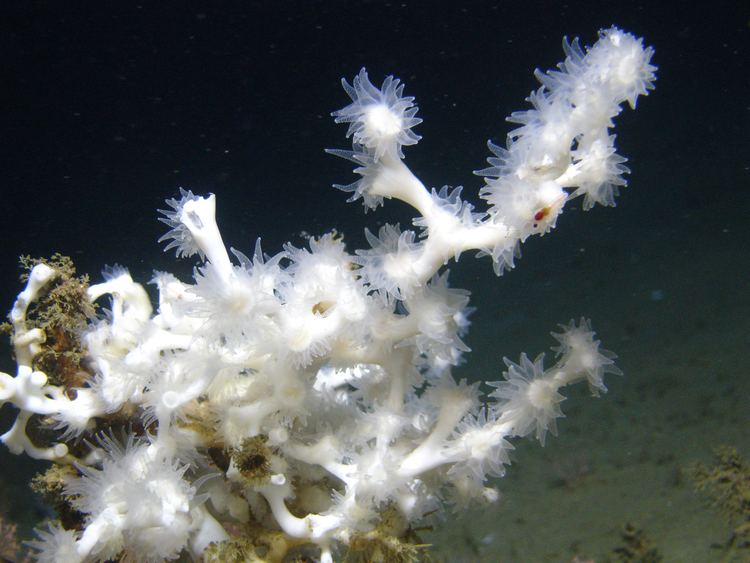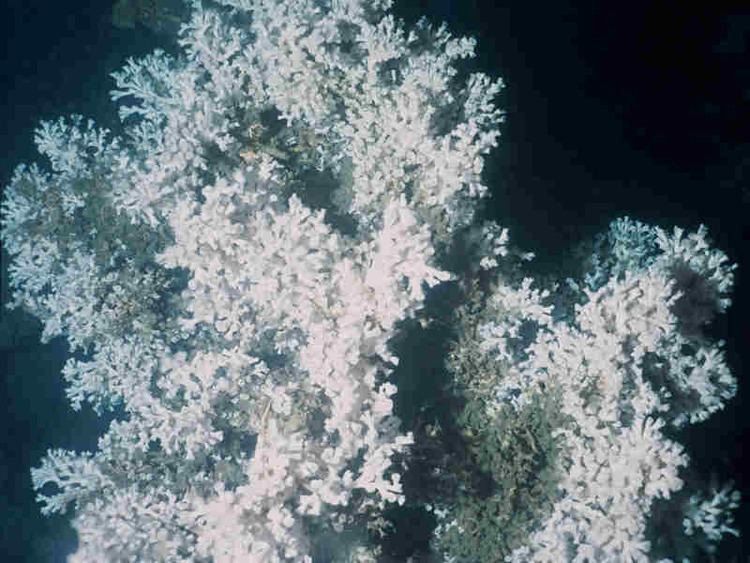Scientific name Lophelia pertusa Higher classification Lophelia | Rank Species | |
 | ||
Similar Madrepora oculata, Madrepore, Scleractinia, Paragorgia arborea, Octocorallia | ||
Deep water corals lophelia pertusa on a steel jacket from the frigg field
Lophelia pertusa, the only species in the genus Lophelia, is a cold-water coral which grows in the deep waters throughout the North Atlantic ocean, as well as parts of the Caribbean Sea and Alboran Sea. L. pertusa reefs are home to a diverse community, however the species is extremely slow growing and may be harmed by destructive fishing practices, or oil exploration and extraction.
Contents
- Deep water corals lophelia pertusa on a steel jacket from the frigg field
- Koraller lophelia pertusa
- Biology
- Conservation status
- Ecological significance
- Range
- References

Koraller lophelia pertusa
Biology

Lophelia pertusa is a reef building, deep water coral, which is unusual for its lack of zooxanthellae - the symbiotic algae which lives inside most tropical reef building corals. Lophelia lives between 80 metres (260 ft) and over 3,000 metres (9,800 ft) depth, but most commonly at depths of 200–1,000 metres (660–3,280 ft), where there is no sunlight, and a temperature range from about 4–12 °C (39–54 °F).

As a coral, it represents a colonial organism, which consists of many individuals. New polyps live and build upon the calcium carbonate skeletal remains of previous generations. Living coral ranges in colour from white to orange-red. Unlike most tropical corals, the polyps are not interconnected by living tissue. Radiocarbon dating indicates that some Lophelia reefs in the waters off North Carolina may be 40,000 years old, with individual living coral bushes as much as 1,000 years old.

The coral reproduces by budding off new polyps and by producing free-living planktonic larvae which float in the water until they find a suitable surface to attach to and grow on.

Lophelia reefs can grow to 35 m (115 ft) high. The largest recorded Lophelia reef, Røst Reef, measures 3 km × 35 km (1.9 mi × 21.7 mi) and lies at a depth of 300–400 m (980–1,310 ft) off the Lofoten Islands, Norway. When this is seen in terms of a growth rate of around 1 mm per year, the great age of these reefs becomes apparent.
Polyps at the end of branches feed by extending their tentacles and straining plankton from the seawater. The spring bloom of phytoplankton and subsequent zooplankton blooms, provide the main source of nutrient input to the deep sea. This rain of dead plankton is visible on photographs of the seabed and stimulates a seasonal cycle of growth and reproduction in Lophelia. This cycle is recorded in patterns of growth, and can be studied to investigate climatic variation in the recent past.
Conservation status
L. pertusa was listed under CITES Appendix II in January 1990, meaning that the United Nations Environmental Programme recognizes that this species is not necessarily currently threatened with extinction but that it may become so in the future. CITES is technically a means of restricting international trade in endangered species, which is not a major threat to the survival of L. pertusa. The OSPAR Commission for the protection of the marine environment of the North-East Atlantic have recognised Lophelia pertusa reefs as a threatened habitat in need of protection.
Main threats come from destruction of reefs by heavy deep-sea trawl nets, targeting redfish or grenadiers. The heavy metal "doors" which hold the mouth of the net open, and the "footline", which is equipped with large metal "rollers", are dragged along the sea bed, and have a highly damaging effect on the coral. Because the rate of growth is so slow, it is unlikely that this practice will prove to be sustainable.
Scientists estimate that trawling has damaged or destroyed 30%–50% of the Norwegian shelf coral area. The International Council for the Exploration of the Sea, the European Commission’s main scientific advisor on fisheries and environmental issues in the northeast Atlantic, recommend mapping and then closing all of Europe’s deep corals to fishing trawlers.
In 1999, the Norwegian Ministry of Fisheries closed an area of 1,000 square kilometres (390 sq mi) at Sula, including the large reef, to bottom trawling. In 2000, an additional area closed, covering about 600 square kilometres (230 sq mi). An area of about 300 square kilometres (120 sq mi) enclosing the Røst Reef closed to bottom trawling in 2002.
In recent years, environmental organisations such as Greenpeace have argued that exploration for oil on the north west continental shelf slopes of Europe should be curtailed due to the possibility that is it damaging to the Lophelia reefs - conversely, Lophelia has recently been observed growing on the legs of oil installations, specifically the Brent Spar rig which Greenpeace campaigned to remove.
Ecological significance
Lophelia beds create a specialised habitat favoured by some species of deep water fishes. Surveys have recorded conger eels, sharks, groupers and hake. The invertebrate community consists of brittle stars, molluscs, amphipods and crabs. High densities of smaller fish such as hatchetfish and lanternfish have been recorded in the waters over Lophelia beds, indicating they may be important prey items for the larger fish below.
Range
L. pertusa has been reported from Anguilla, Bahamas, Bermuda, Brazil, Canada, Cape Verde, Colombia, Cuba, Cyprus, Ecuador, Faroe Islands France, French Southern Territories, Greece, Grenada, Iceland, India, Ireland, Italy, Jamaica, Japan, Madagascar, Mexico, Montserrat, Norway, Portugal, Puerto Rico, Saint Helena, Saint Kitts and Nevis, Saint Vincent and the Grenadines, Senegal, South Africa, United Kingdom, United States of America, U.S. Virgin Islands and Wallis and Futuna Islands.
